How to Style and Coordinate with Throw Pillows
I love to share with you the themes, trends and things that inspire me. So, today I thought I would give you a guide to how you best can coordinate fabrics, patterns and throw pillows:
FRESHEN IT UP WITH PILLOWS
If you are ready to freshen up your home, maybe to find something new to go with the season, I suggest starting with throw pillows. Changing up your pillows can create a new look to your sofa, that old chair or your bed. Pillows are a simple and great way to make a statement in any room.
IT’S NOT ROCKET SCIENCE BUT…
Some people think that picking out a few throw pillows and placing them on the sofa is easy. «There is no need to put so much thought into it!»
Actually, I agree. After all, combining throw pillows is not exactly rocket science. However, for those of you, who get a bit overwhelmed by the idea of combining patterns, textures and colors – and who is maybe secretly looking for a designer’s touch, I will help you out with some pointers, using a few simple formulas, which have served me well throughout my career as an interior designer.
Let us start looking at some of the main categories/styles of throw pillow that is offered on the market. (See illustration 1). Knowing your pillow styles and how to name them will make you sound like a professional when you are out shopping. Maybe you will even impress the people working in the shops, or a friend or a neighbor.
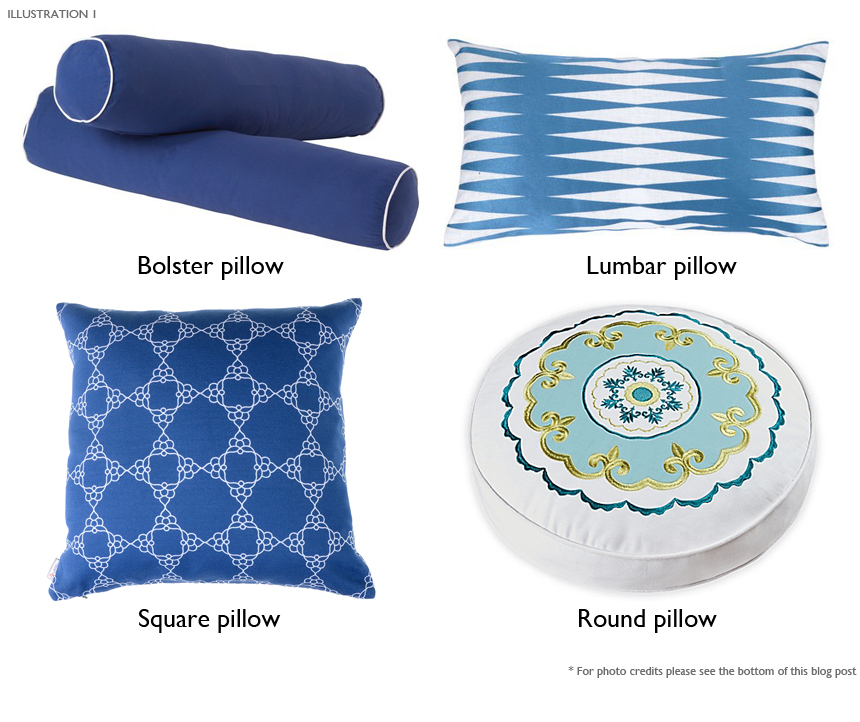
SIZE DOES MATTER
The size of a throw pillow should be in harmony – in other words, determined by the size of your sofa, chair, bed or wherever you wish to place your pillows. Keeping this in mind, you are of course «allowed» to mix and match different categories/styles in various sizes. Trust your instinct! You will see it if the pillows become either too small or too big.
So, in general, on a large sofa (with or without a chaise) or a sectional (corner-sofa) it would look odd and strange with just one or a couple of too small pillows. Since most people, have fairly big sofas, pillows measuring 18 x 18 inches or 20 x 20 would give the best visual impression. It simply looks better. It would then, be smarter to add on with smaller pillows together with the bigger ones. It gives you a more exciting mix.
Naturally then, for a smaller sofa or chairs, I would recommend using bolster, lumbar and rectangular shaped throw pillows.
MAKE IT A FAMILY
With a better understanding of styles and sizes, let us turn to how we can coordinate patterns and/or colors.
If pillows are united by color, texture or pattern, they more likely will match harmoniously with one another. So, a good rule is to pick two or three different pillow designs belonging to the same color family. For example mixing pillows that all have different shades of blue.
On the other hand, you can forget about the colors, and alternatively pick the same pillow design/pillow pattern in different colors. In that way you can, as we say in the design industry, anchor your pillow selections. However, when you choose this option, always make sure the colors you choose can be found in other objects in the room. This could be your carpet, curtains, accessories etc. This is important in order to tie it all together and give your room a bit of that designer’s touch.
THE FORMULAS
Now that you know more, let me give you a few concrete, practical formulas of How-to-do-it.
1. Deciding on your color palette
Look around in your room, what do you see, what do you like, what demands your attention? Or maybe you should forget the colors you see and rather change things up completely by picking different colors. Keep in mind the colors you choose should either:
1.1) be analogous, in other words corresponding with each other – typically three or more hues within «neighboring colors», they have matching nuance, temperature and energy. For example browns, oranges, yellows and reds.
Or
1.2) be complementary, in other words colors which are strong opposites of each other. These colors make each other appear brighter and they create exciting, vibrant effects. Be aware they can then also become demanding on the eye. So, be brave and modest at the same time!
2. Choose two different pillow designs: one with a solid color + one with a pattern (See illustration 2 & 3)
In this option you can either stick to analogous or complementary colors as explained above. You simply find two pillow designs, which have the same or opposite colors. Similar colors would work best on darker backgrounds, for example a dark grey sofa, while opposite colors would maybe work better on a white or cream colored sofa or chair.
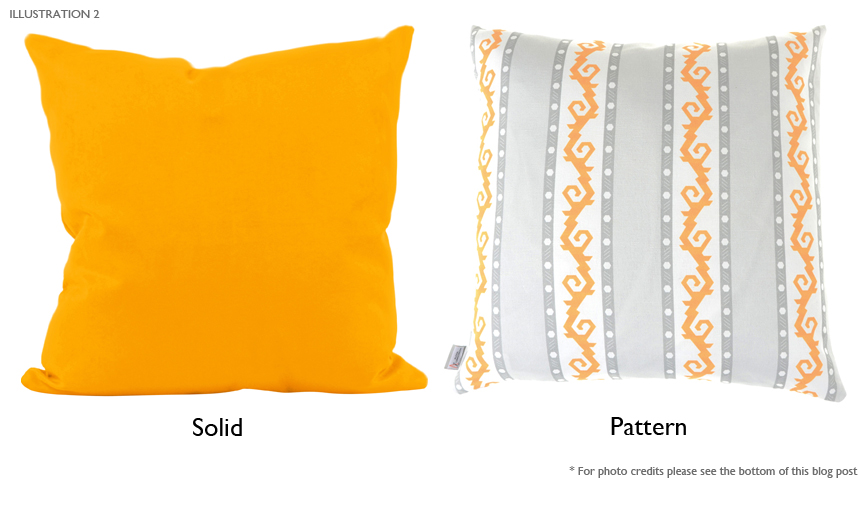

3. Choose two different pillow patterns: one big pattern + one small pattern (See illustration 4 & 5)
This is actually common sense, and the key word is contrast. By carefully and consciously choose pillows, which have patterns in different sizes, you actually make each pattern stand out more. The patterns will then balance each other, instead of fighting for the attention. Only small patterns will not be individual enough and only big patterns will overwhelm you.
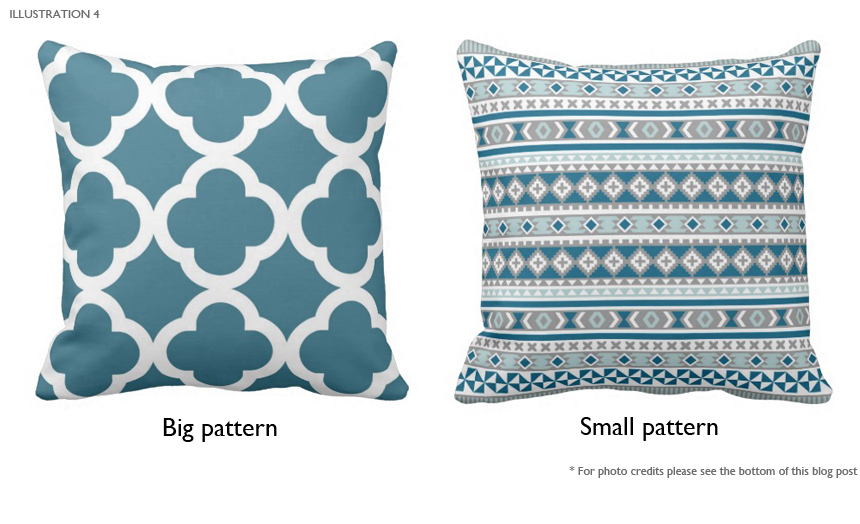
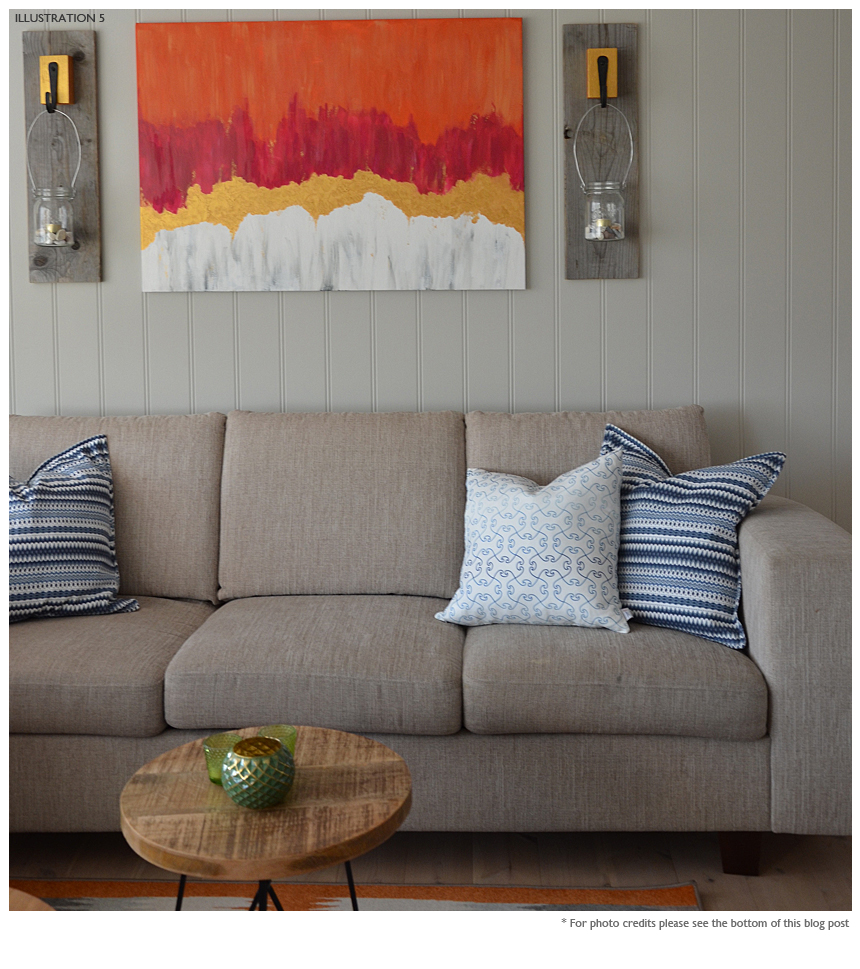
4. The rule of three (See illustration 6 & 7)
This well-know design-rule comes in handy, especially when you would like to have more than two different kinds of pillows: Odd numbers work well together when you are grouping objects, for example throw pillows. In other words, it is better to have 3, 5, 7 pillows, than 2, 4, 6… Try it and you will probably see it! So, I recommend grouping three pillows instead of four. Don’t be square, think in triangles!
When it comes to grouping three (or more) pillows, keep in mind:
First, choose your pillow number one; it should be the one with your lead pattern. So, what do I mean with that? Pillow number one is your main pillow, the one you love the most, the one that sets the standard for the other pillows you will choose, the one that stands out the most. It is your statement pillow. Naturally then, it should have the largest, strongest pattern, for example, a big flower pattern or a striking graphic pattern. Ideally – and I would highly recommend this – pillow number one should have a design consisting of multiple colors.
Then you choose your pillow number two. Here I would go for a striped, dotted or scaled down pattern compared to the lead pattern on pillow one. And choose a pattern, which has only one of the colors in the lead pattern on pillow number one.
Finally, pillow number three. To complement the two other pillows, you should choose a pillow with either one, solid color or you could alternatively choose a pillow with tone-on-tone colors. However, keep it small scaled, so that it appears to be a solid colored pillow.

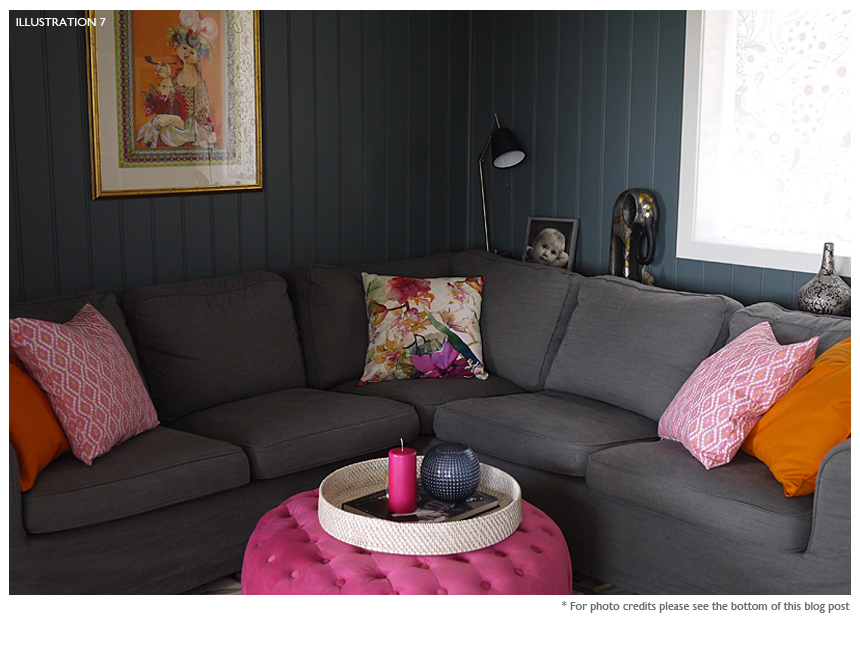
5. Mix and match textures
The last formula I will share with you concerns texture and materials – how the surface looks and feels. Basically this is nothing radically new but it is a different way to create contrast and excitement in your interior. In addition, using different textures adds a new feeling of volume and statement. However, when making brave choices of purchasing pillows with maybe completely different in texture, for example fur and linen, velvet and leather, I would recommend staying close to a monochromatic color palette.
As you can see on other parts of my website – and on my Etsy store – I have my own pillow collection. It is very exciting and a lot of hard work. It’s a bit scary to stick my head out and say «check out my things!». I have thought many times: «What if people don’t like it?» … But I’m really proud of it!
I hope you found this blog post interesting and that my guide to coordinating throw pillows left you with some useful tools in order to choose your new pillows, whether they are for your sofa, chairs or bed. Feel free to check out my collection, too. Should you have any questions or comments, feel free to send them to me.
Thank you for reading! Good luck choosing your pillows!
xoxo, Alexia

I never knew there was so much to actually learn and think about when it comes to throw pillows. I am so impressed with your knowledge and professional way to explain such design principles. I hope this blog post can be useful and interesting for many readers.